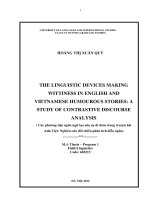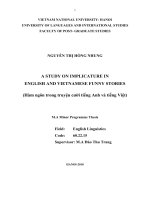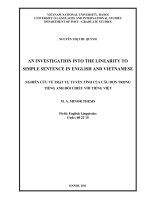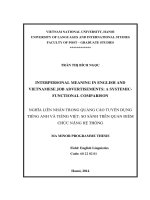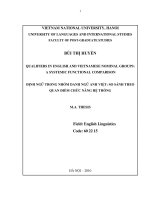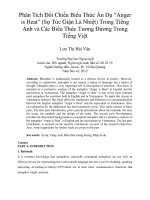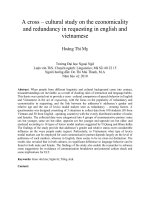The linguistic devices making wittiness in English and Vietnamese humourous stories a study of contrastive discourse analysis
Bạn đang xem bản rút gọn của tài liệu. Xem và tải ngay bản đầy đủ của tài liệu tại đây (189.89 KB, 7 trang )
The linguistic devices making wittiness in
English and Vietnamese humourous stories: a
study of contrastive discourse analysis
Hoàng Thị Xuân Quý
Trường Đại học Ngoại ngữ
Luận văn Thạc sĩ ngành: English Linguistics; Mã số: 60 22 15
Người hướng dẫn: Ph.D. Ngô Hữu Hoàng
Năm bảo vệ: 2012
Abstract. Reading humourous stories is the good means of entertainment because it can
help the readers to release the stress and reduce the tension. Beside the function of
entertainment, humour is the special means of reaching the better things which satisfy
the progressive thoughts and the lower-class‟s dream of equality. This study is aimed at
investigating the figure of speech as linguistic devices in the English humourous stories
and Vietnamese humourous stories. The analysis is carried out on 50 samples collected
from the different books of English and Vietnamese humourous stories. The results
show that there is the similarity in the using of metaphor between these two languages.
Besides, Vietnamese humorous stories have the higher percentage of metonymy,
comparing to English humourous stories. Context is the important element that helps the
reader to understand and interpret the figure of speech in the humourous stories.
Furthermore, the study offered the implications of translating and teaching so that the
translator and teachers can use in their jobs.
Keywords. Ngôn ngữ học; Phân tích diễn ngôn; Tiếng Anh
Content
1. Rationale
It cannot be denied that humour plays an important role in the human life and the whole society
because it is not only the means of entertainment but also the weapon to criticize the groups of
people with the purpose of clearing away the negative attitudes, the out-date thoughts, the
discrimination existing in the society. Besides, humour is the special means of reaching the better
things which satisfy the progressive thoughts and the lower-class‟s dream of equality. The
laughter at the specific objects with the deeply social meanings always carries the humour and
exists long in the spiritual products of human beings. In the relation with the humour, the
laughter is indispensable, but the humour may also include wittiness, joke, criticism, etc. About
these categories, the researcher is going to mention in the next part of the study so that there is a
full overview of what is investigated into.
It is said that Aristot is one of the first author that investigated the nature of humour when he
stated that the humour is aesthetic. However, it is necessary to note that the humour is aesthetic
only when it is aimed at the specific object with the deeply social meanings. The humour was
born out of hostility. If there had been no hostility in man, there had been no laughter (and,
incidentally, no need for laughter). All the current humour and wittiness retain evidence of this
hostile origin types.
Furthermore, humour is the product of the society when people, by different means, make the
laughter in the spiritual works like the HS, the play, the cartoons, the funny pictures and movies,
etc. Among those types of literature, the short humourous stories (hereafter called HS) are really
important in amusement by just some short sentences, and it is easy for the readers to provoke
the laughter at ease to entertain or satire the negative sides of human beings or the whole society.
Being different from the other types of art like cartoon, funny pictures and play; the humorous
stories use the only means of language to express the laughter like the following story:
Phát triển không đồng đều
Buổi tối, anh thợ làm bánh mì thường dẫn người yêu ra ghế đá công viên. Có lần anh hỏi:
- Em yêu, tại sao cứ nửa buổi hẹn hò là em đổi chỗ bên này qua bên kia vậy?
Cô gái bẽn lẽn:
- Tại vì nếu em cứ ngồi mãi một bên như vậy thì cơ thể em sẽ phát triển không đồng đều.
Translated version:
Develop unequally
In the evening the baker often takes his girl friend to the park bench.
Once he asked her:
- My dear, why do you change your side after the half-date?
She answered softly:
- Because if I remain one side, my body would develop unequally.
In the past, there were a lot of studies about the humour of scholars, humorists, philosophers and
psychologists, dating back as far as Plato, Socrates and Aristotle, to Darwin and Freud, Eastman
and Pittington, through to Koestler and Midess; plus more than 100 theories of humour and
laughter, some of them brilliant investigations into the social and behavioral nature of humour
and laughter. According to the standard analysis of Internet Encyclopedia of Philosophy (internet
23), humor theories can be classified into three neatly identifiable groups: the incongruity,
superiority, and relief theories. Incongruity theory is the leading approach and includes historical
figures such as Immanuel Kant, Soren Kierkegaard, and perhaps has its origins in comments
made by Aristotle in the Rhetoric. The paradigmatic superiority theorist is Thomas Hobbes
(1958: c.8, internet 5), who said that humor arises from a “sudden glory” felt when we recognize
our supremacy over others. Plato and Aristotle are generally considered superiority theorists,
who emphasized the aggressive feelings that fuel humor. The third group, relief theory, is
typically associated with Sigmund Freud and Herbert Spencer, who saw humor as fundamentally
a way to release or save energy generated by repression. Today, there are two well-known
linguistics as Salvatore Attardo and Victor Raskin with Script-Based Semantic Theory Of
Humour (SSTH) and The General Theory Of Verbal Humour (GTVH) respectively. The main
hypothesis is quoted by Avro Krikman (2006:31, internet 7) as follows:
SSTH is the theory refers to a text which can be characterized as a single-joke-carrying text if
both of the conditions are satisfied. The text is compatible, fully or in part, with two different
scripts. The two scripts with the text is compatible are opposite in a special sense defined in
section 4. The two scripts with which the text is compatible are said to overlap fully or in part on
this text.
GTVH is presented as a theory that allows us to relate perceived differences between jokes to six
hierarchically ordered Knowledge Resources (parameters), namely knowledge concerning
Language; Narrative Strategies; Target(s); Situation; Logical Mechanism(s); Script
Opposition(s).
The investigation of the linguistic devices making the wittiness by discourse analysis is a large
field that was implemented by the linguistics in the world. Generally, this matter is investigated
and explored long before by many people in the field of language. However, everything seems to
be different in Vietnam because the study of humour is less and the study by discourse analysis,
especially the professional and contrastive one of English humourous stories and Vietnamese
humourous stories (hereafter called EHS and VHS respectively). Let‟s begin with Vũ Ngọc
Khánh who presented us the book named Hành Trình Vào Xứ Sở Cười (translation: The Journey
to the Land of Laughter) in 1996. He gave us the overview of VHS, including the folklores and
the scholar-styled literatures on the aspects of time and space. During the history, Vũ Ngọc
Khánh (1996:7) claimed that from the 17
th
century, VHS has developed with the appearance of
Trạng Quỳnh collection whose the objects to be laughed at were the king, officials, Gods and
Budda, monks, traders, etc. Also from this century, we have had other scholar-styled authors like
Nguyễn Bá Lân or Nguyễn Cư Trinh, and in the modern time there are Tú Mỡ, Tú Xương, Vũ
Trọng Phụng, Nguyễn Công Hoan, Bút Tre, etc. About the aspect of space, he stated that the
humour is created by people in the specific lands like Vĩnh Hoàng village, Đông Anh villages,
Hòa Làng villages (Vũ Ngọc Khánh, 1996, p.54). One more point in his book is that he
introduced us the linguistic uses for making laughter, including puns, slang and bad language.
We can find the words having the co-equal meanings as follows: ‘Lên phố Mía gặp cô hàng mật,
cầm tay kéo lại, hỏi thăm đường’ (Translated version: Downtown to Sugarcane street, see Miss.
Treacle, ask her the direction). Another author should be mentioned is Nguyễn Hoàng Yến when
he discovered the pragmatic mechanism through the disseration: „ Truyện Cười Dân Gian Việt
Nam Dưới Góc Độ Dụng Học‟ (The Vietnamese Folklores: A Study of Pragmatics). Based on the
cooperation principles of Grice Maxim, politeness principles, reference and implicature, Nguyễn
Hoàng Yến (2011: 110) found out that implicatures in conversation appeared at the closings of
the stories and played the substantial role in making laughter. The implicatures of the opening
and the body is the only cause and condition for the closings and the lessons of morality would
be from such implicatures. Nguyễn Thị Hồng Nhung is the author of the master thesis:
‘Implicature in English and Vietnamese funny stories’. In this study, she discovered both
languages have the same implicature mechanism based on flouting or violating the maxims that
are important for the writers in order to evoke feelings and reactions in their readers (Nguyễn Thị
Hồng Nhung, 2010, p.37).
It can be seen that there have not been any study of HS under discourse analysis and contrastive
between English and Vietnamese implemented before by any researchers in Vietnam, so the
author of this study believes that this would be the first time this subject is carried out and hopes
that it would be new approach to the humour under discourse analysis in Vietnam as well as to
the literature of which HS are the object of the study. In addition, the study would be helpful for
the translators to be good at their translation from English and Vietnamese and vice verse
because when reading the literature works, in terms of the discourse analysis views, the readers
not only understand the humour mechanism, the linguistic devices, the nature of humour, etc but
also are supplied with the knowledge of language, people characteristics, attitudes and thoughts
of the culture the stories belong to. Besides, the study also is necessary for the teachers in their
jobs because it is said that the successful teacher need to have good sense of humour. Through
the study, the knowledge would be helpful for them to tell the jokes in the appropriate time to be
the warm-up activities.
2. Aims of the study
- In the study, the researcher investigates the figure of speech as linguistic devices
making the wittiness and then help us to understand/explain why people laugh when
reading EHS and VHS.
- The role of context in the HS, then readers can understand the jokes by the context
when reading them.
- To provide implications for the translators to understand the jokes in the stories and
have good interpretation with the right transfer. Besides, it is necessary to tell HS in
language teaching, then the students can be supplied with language knowledge,
cultures and motivated in learning, warm-up activities and release their study tension.
3. Scope of the study
The types of humour can be cartoons, funny pictures, plays, etc. However, this study is limited to
the verbal humour. The object of research is the EHS and VHS.
This research is limited to investigate the figure of speech as the linguistic devices like metaphor,
metonymy and others which make the wittiness in the selected EHS and VHS
4. Method of the study
By means of quantitative method, the investigation is carried out through text analysis, previous
researches, individual analysis and observations.
Data are gathered in the books collection of EHS and VHS.
Based on the collected books, the samples shall be sorted out in terms of the figure of speech as
linguistics devices and types of the theory of humour.
5. Organization of the study
There are three main parts in the study as follows:
Introduction
This part includes rationale, aims of the study, scope of the study, organization and methods of
the study.
Development
Chapter 1: The Theoretical Background.
The researcher represents the ideas of other linguistics and researchers about their previous
studies and books to build up the theory as the background for this study to be based on and
develop.
Chapter 2: The Study.
This part gives the detailed description of the study, which includes data collection, data analysis
and the results and discussion
Chapter 3: Implication of Translation and Teaching
In this part, the researcher offers the implications for the translator and teacher how to apply the
humour in their jobs.
Conclusion
This is the last part of the thesis which summaries the findings and makes suggestions for the
translators and teacher; and a further study.
References
Book sources:
Bassnett, S.(1992). Translation studies (p.p21). London: Routledge.
Đặng Việt Thủy. (2010). Tiếu Lâm Việt Nam Hiện Đại (p.p6-277). Thanh Hóa: Nhà Xuất Bản
Thanh Hóa
Đức Tài. (2012). Truyện Hay Quốc Tế - The World Of English Humour. (p.p3-105). TpHCM:
Nhà Xuất Bản Dân Trí
Đức Tài & Diên Khánh (2012). Truyện Hài – Best Funny Stories (p.p3-105). TpHCM: Nhà Xuất
Bản Dân Trí.
Finegan, E. (2004). Language: Its Structure and Use (p.p197). Boston & Massachusetts:
Thomson-Wadsworth.
Lobner, S. (1999). Understanding Semantics (p.p48-51). London: Arnold
Lakoff, G & Jonhson, M. (1984). Metaphor We Live By (p.p3-35). Chicago & London: The
University of Chicago Press.
Levinson, C, S. (2000). Pragmatics (p.147). Cambridge: Cambridge University Press.
Nunan, D. (1993). Introducing Discourse Analysis (p.p5-51). England: Penguin English.
Nguyễn Quốc Hùng. (2009). Nụ Cười Nước Anh. (p.p 5-324). Hà Nội: Nhà Xuất Bản Thanh
Niên.
Nguyễn Thị Hồng Nhung. (2010). Implicature in English and Vietnamese Humourous Stories
(p.37). Hà Nội: University of Language and International Study Language
Ngọc Hà. (2012). Truyện Cười Dân Gian Việt Nam (p.p5-180). Hà Nội: Nhà Xuất Bản Văn Hóa-
Thông Tin
Nguyễn Hòa. (2008). Phân Tích Diễn Ngôn – Một Số Vấn Đề Lí Luận Và Phương Pháp (p.p1-
281).Hà Nội: Nhà Xuất Bản Đại Học Quốc Gia Hà Nội.
Nguyễn Hòa. (2000). An Introduction to Discourse Analysis (p.p43). Hà Nội: Đại Học Quốc Gia
Hà Nội.
Nguyễn Hoàng Yến (2011). Truyện Cười Dân Gian Việt Nam Dưới Góc Độ Dụng Học (p.110).
Hà Nội: Học Viện Khoa Học Xã Hội
Nguyễn Thiện Văn & Lương Vĩnh Kim (2008). 120 Mẩu Chuyện Vui Anh-Việt – 120 English-
Vietnamese Humourous Stories. (1). (p.p4-145) Đà Nẵng: Nhà Xuất Bản Đà Nẵng
Nguyễn Thiện Văn & Lương Vĩnh Kim (2008). 120 Mẩu Chuyện Vui Anh-Việt – 120 English-
Vietnamese Humourous Stories. (2). pp4-145 Đà Nẵng: Nhà Xuất Bản Đà Nẵng
Ross, A. (1998). The Language of Humour (p.p1-63). London & New York: Routledge
Richards, J, C, Platt, J & Platt, H. (2000). Dictionary of Language Teaching & Applied
Linguistics. USA: Longman
Saeed, I, J. (2003). Semantic Description (p.345). Oxford: Blackwell Publishing
Tam Tam (2011). Cười…Hở Mười Cái Răng (p.p3-299). TpHCM: Nhà Xuất Bản Thanh Niên
Vũ Ngọc Khánh. (1996). Hành Trình Vào Xứ Sở Cười. Hà Nội: Nhà Xuất Bản Giáo Dục.
Internet sources:
Internet 1: Attardo, S. & Raskin, V. (1994). Linguistics Theory Of Humour. (p.p1-20). Retrieved
from
/>summary_r&cad=0#v=onepage&q&f=false
Internet 2: Armali, F. (2012). Loss And Gain In Humour Translation; A Case Study Of The
Ethics Of The Aristocrats (p1-3). Retrieved from
/>case-study-of-The-Ethics-of-the-Aristocrats
Internet 3: Dynel, M. (2009). Creative Metaphor Is A Birthday Cake: Metaphor As The Source of
Humour (p.p29-31). Retrieved from />cake-metaphor-as-the-source-of-humour-w1633
Internet 4: Freud, S. (1960). Jokes and Their Relation to The Unconscious. Retrieved from
/>unconscious+by+Freud&dq=jokes+and+their+relation+to+the+unconscious+by+Freud&source=
bl&ots=hV52WB2Ok-
&sig=unbu7JM2a8l4PYZweK1wteywoks&hl=en&sa=X&ei=0xhXUMWtMPCziQfJ04CoBw&
ved=0CC0Q6AEwAA
Internet 5: Hobbes, T. (1958). Leviathan. (c.8). Retrieved from
/>bbes&dq=Human+Nature+by+Thomas+Hobbes&source=bl&ots=tTJGnkeZDF&sig=SkZ4nVpZ
vQOi3UeIstB3H5iebgU&hl=en&sa=X&ei=tR1XUIPxMcSOiAfsi4G4CA&ved=0CDIQ6AEwA
Q
Internet 6: Hantoro, S. (2008). The Violatd Maxims And The Illocutionary Act Types Found In
Humour Comic of Master Q. (p.p6-7). Retrieved from http://hantoro-
hsp.blog.com/2008/09/violated-maxims-and-illocutionary-act_17.html
Internet 7: Krikman, A. (2006). Contemporary Linguistic Theories of Humour (p.p33-36).
Retrieved from
Internet 8: Jarande, A. (2006). What Humour Tells Us About Discouse Theories. (p.31).
Retrieved from
Internet 9: Lippit, J. (1995). Humour and Superiority. (p.11). Retrieved from
Internet 10: Nguyễn Đức Dân. (1977). Ngôn ngữ, Lô-gic và những ‘nụ cười’ (p.1). Retrieved
from
Internet 11: Nguyễn Thiện Khanh (2011). Truyện Cười và Ngôn Ngữ. (p.1-4). Retrieved from
Internet 12: Nieto, R. (2011). Humour in Woody Allen’s Anything Else. (p.p20-21). Retrieved
from
Internet 13: Sachiko Kitazume. (2006). Cognitive Models of Humor and Metaphor. (p.p1-33).
Retrieved from
s&source=web&cd=1&ved=0CCIQFjAA
&url=http%3A%2F%2Fkurepo.clib.kindai.ac.jp%2Fmodules%2Fxoonips%2Fdownload.php%3
Ffile_id%3D3097&ei=XtxXUNfPDeXZigfR1oHoAw&usg=AFQjCNEz8xbveSPrtz4JOjoIfXk8
Zdj_sA
Internet 14: Schopenhauer, T & Kant, I. (1970). The Critique of Judgment. (p.77). Retrieved
from
/>+Judgement+by+Schopenhauer&source=bl&ots=54lfSU973D&sig=QcGkKArd7m_2nOTSHBL
eWYogT6M&hl=en&sa=X&ei=HRxXUM2HEcWaiAeVyICoDg&ved=0CDkQ6AEwAg#v=on
epage&q&f=false
Internet 15: Trần Thiện Khanh. (2009).Bước Đầu Nhận Diện Diễn Ngôn, Diễn Ngôn Văn Học,
Diễn Ngôn Thơ (p.p1-3). Retrieved from http://khoavanhoc-
ngonngu.edu.vn/home/index.php?option=com_content&view=article&id=1464%3Abc-u-nhn-
din-din-ngon-din-ngon-vn-hc-din-ngon-th-bai-1&catid=94%3Aly-lun-va-phe-binh-vn-
hc&Itemid=135&lang=vi
Internet 16: Veale, T. (2003). Metaphor and Metonymy: The Cognitive Trump-Cards of
Linguistic Humour. (p.p1-3). Retrieved from
Internet 17: Veiga, J, M. (2009). Linguistic Mechanism Of Humour Subtitling. 4
th
Forum for
Linguistic Sharing. Retrieved from
Internet 18: Yakin, Orhun (1999) Translation of humour with special reference to the cartoons in
'Leman' and other popular weekly humour magazines of Turkey. PhD thesis, University of
Warwick. Retrieved from:
Internet 19: Wei Liu (2010). Cohesive Device Analysis in Humor. (p.1). Retrieved from
Internet 20:
Internet 21: />cuoi.html
Internet 22:
/>&url=http%3A%2F%2Fwww.lexically.net%2Fwordsmith%2Fcorpus_linguistics_links%2FRoe
mer%2520208%2520HSK%2520CL%2520chapter%2520final%2520print%2520version.pdf&ei
=EllqUNyINdHQrQeW84GIAw&usg=AFQjCNHNF01Tu-8bR7KXwlBvJC0UHg2cmQ
Internet 23:
Internet 24:

